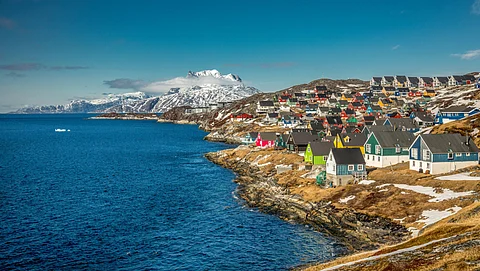

Wild-caught seafood giant Royal Greenland is ready to commercialise its Greenland-grown seaweed, the company has announced, with the first major harvest expected this year.
The news follows five years of research and development led by Royal Greenland biologist and innovation specialist Nikoline Ziemer.
The Greenlandic seafood company intends to process the seaweed for consumer products targeted towards the European market, including pesto, seasonings and salads.
Convinced that the Greenlandic fjords would be suitable for seaweed production due to "varying currents and high nutrient levels", Ziemer has been working since 2018 on developing the best method for producing seaweed in Greenland's cold climatic conditions.
Ziemer started with a micro hatchery indoors, continuing with small-scale ocean experiments in the waters of Maniitsoq in western Greenland. In the summer of 2022, a larger seaweed farm was set up at Inuttooq, 3.5 nautical miles from the first experimental site.
"It is fantastic news that we can now grow seaweed for commercial use. It's another great opportunity to develop local production and create a better economy for both Royal Greenland and Greenland," Ziemer said.
In February of this year, Royal Greenland announced that it had secured funding of 5,5 million DKK (almost 740,000 EUR) to scale up its seaweed operations from experimental units to commercially viable production.
"Greenland presents a unique opportunity to grow seaweed of very high quality, which we are tapping into with this project. Over the next few years, we are aiming towards a good harvest of approx. 38 tonnes, that we can process and sell," Royal Greenland COO Lars Nielsen said, announcing the funding in February 2023.
"We see a great potential for seaweed in Greenland. In the future, we hope to have a production capable of delivering much larger quantities," Nielsen added.
Announcing the commercialisation on its website, Royal Greenland said that expanding seaweed production in Greenland can help to support coastal communities, as production "can be optimally located near the smaller settlments where good jobs are needed".
However, Royal Greenland notes that Asian-produced seaweed's price advantage means it currently dominates the market for seaweed as a raw material in the food industry.
As a result, the Greenland company has decided to focus on the European consumer market, with seaweed potentially atractive to consumers both for its sustainability profile and its nutritional content of plant-based protein.
"So far, we have created a series of very tasty seaweed pestos and are working on a seaweed salad that is ideal as a side dish for fish and shellfish," said Jan Soinjoki, Product Development Manager
"Nutritionally, we are dealing with a so-called "superfood" – it is the most nutritious plant on the planet – seaweed contains more iron than spinach, more vitamin C than oranges and more calcium than milk, just to name a few".
Royal Greenland is a vertically integrated company fully owned by the government of Greenland. It is one of the world's largest suppliers of cold-water prawns and Greenland halibut. The company's fishing activities are concentrated in the North Atlantic and Arctic Oceans, and it owns and operates more than 40 landing and processing facilities in Greenland, Canada and Europe. Its sales and distribution networks are set up in various locations throughout Europe, North America and Asia.
